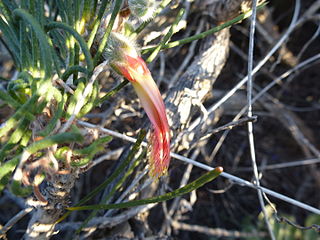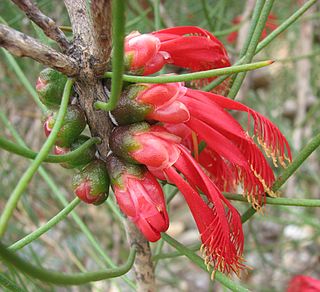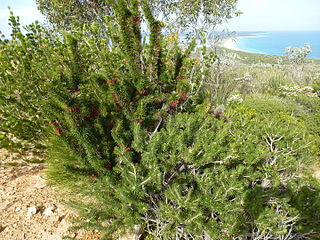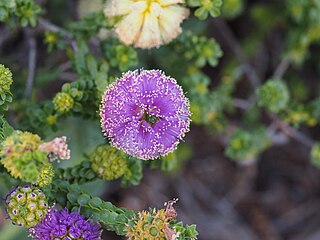
Lasiopetalum maxwellii is a species of flowering plant in the family Malvaceae and is endemic to the south coast Western Australia. It is a sprawling shrub with hairy young stems, lance-shaped to oblong leaves and white to cream-coloured flowers.

Phymatocarpus is a genus of flowering plants in the family Myrtaceae and is endemic to the south-west of Western Australia. All three species are shrubs with pink to purple flowers.

Melaleuca nematophylla, commonly known as wiry honey-myrtle is a plant in the myrtle family, Myrtaceae and is endemic to the south-west of Western Australia. It is one of the showiest melaleucas when in flower in early spring, is easily grown and has unusual needle-like foliage. As a result, it is relatively common in cultivation in temperate parts of Australia.

Calothamnus chrysanthereus , commonly known as claw flower is a plant in the myrtle family, Myrtaceae and is endemic to the south-west of Western Australia. It is an erect shrub with needle-shaped leaves crowded on the ends of the branches and bright red flowers in spring.

Calothamnus gilesii is a plant in the myrtle family, Myrtaceae and is endemic to the south-west of Western Australia. It is an erect, usually compact shrub with fine, pine-like foliage and which produces cluster of red flowers from June to January.

Calothamnus pinifolius, commonly known as dense clawflower, is a plant in the myrtle family, Myrtaceae and is endemic to the south-west of Western Australia. It is an erect shrub with dense foliage and clusters of red flowers, partly immersed in the prickly foliage, between July and January.

Melaleuca acuminata, commonly known as mallee honeymyrtle is a plant in the myrtle family, Myrtaceae and is native to Australia and widespread in temperate areas of the continent. It is an erect shrub to about 3 m (9.8 ft) usually found in mallee woodland.

Melaleuca bisulcata is a plant in the myrtle family, Myrtaceae and is endemic to a relatively small area on the west coast of Western Australia. It is difficult to distinguish this species from Melaleuca psammophila except on differences in the shape of the calyx lobes.

Melaleuca filifolia, commonly called wiry honey-myrtle, is a plant in the myrtle family Myrtaceae, and is endemic to the south-west of Western Australia. It is a woody, twiggy shrub with needle-shaped leaves, greenish flower buds, pink "pom-pom" flower heads and spherical clusters of fruits.

Melaleuca glaberrima is a plant in the myrtle family, Myrtaceae and is endemic to the south-west of Western Australia. It is a dense, spreading shrub with needle shaped, but not sharp leaves and profuse pink or mauve flowers.
Calothamnus blepharospermus is a plant in the myrtle family, Myrtaceae and is endemic to the west coast of Western Australia. It is an upright, spreading, bushy shrub with red flowers in summer. It grows in sandy soil in scrubby country called kwongan.

Calothamnus longissimus is a plant in the myrtle family, Myrtaceae and is endemic to the south-west of Western Australia. It is a small, spreading shrub with unusually long, fine leaves and which produces clusters of red flowers in spring.
Calothamnus microcarpus is a plant in the myrtle family, Myrtaceae and is endemic to the south-west of Western Australia. It is an erect, either compact or spreading shrub with flat leaves and clusters of red flowers in spring.

Calothamnus oldfieldii is a plant in the myrtle family, Myrtaceae and is endemic to the south-west of Western Australia. It is a small, spreading shrub with needle-shaped leaves and clusters of red flowers with 5 petals and 5 stamen bundles.

Eremaea acutifolia, commonly known as rusty eremaea, is a plant in the myrtle family, Myrtaceae and is endemic to the south-west of Western Australia. It is a small shrub with needle-like leaves and which bears orange-coloured flowers on short side branches and fruits with a surface that is rough to the touch.

Eremaea violacea is a plant in the myrtle family, Myrtaceae and is endemic to the south-west of Western Australia. It is low, spreading shrub with narrow, prickly leaves and which bears violet-coloured flowers on short side branches.

Beaufortia orbifolia, commonly known as Ravensthorpe bottlebrush, is a species of flowering plant in the myrtle family, Myrtaceae and is endemic to the southwest of Western Australia. It is an erect or spreading shrub with round, dished leaves crowded on the younger stems, and bright red flower spikes. It is found in laterite hills near Ravensthorpe. It is distinguished from other beaufortias by having green stamen bundles with the free ends red.

Phymatocarpus porphyrocephalus is a plant in the myrtle family, Myrtaceae and is endemic to the south-west of Western Australia. It resembles many small species of Melaleuca, mainly differing in the way its anthers are attached at the top of the stamens. In Phymatocarpus they are attached at their base and open at the other end through two slits. It is a shrub with many small heads of pink to purple flowers fading to white, often covering the plant for several weeks in spring.
Verticordia minutiflora is a flowering plant in the myrtle family, Myrtaceae and is endemic to the south-west of Western Australia. It is a bushy shrub with small, crowded, cylindrical leaves and groups of white to pale pink flowers in summer and autumn. As suggested by its botanical name, it has the smallest flowers of any verticordia.

Beaufortia puberula, commonly known as hairy-leaved beaufortia, is a plant in the myrtle family, Myrtaceae and is endemic to the southwest of Western Australia. It is a shrub growing to a height of about 2 m (7 ft) with hairy young leaves and heads of hairy, pink or red flowers during most of the year.


















